- Home
- >
- Preservation Archaeology Blog
- >
- Reaching out to Indigenous Youth
(July 31, 2024)—We had three incredible opportunities to spend quality time with Indigenous young people this summer. Here, I share my reflections on those occasions, as well as those of some of my colleagues who were also present.
Bryan Brown Youth Academy
On June 6, 2024, Archaeology Southwest had the privilege of spending a day with the Bryan Brown Youth Academy. The academy is named in honor of Officer Bryan Brown, Tohono O’odham Police Department, who fell in the line of duty.
From a press release put out by Tohono O’odham Nation in 2020:
“Officer Bryan Brown lived a life of public service. A veteran of the U.S. Army, he was with the Tohono O’odham Police Department for 19 years, including 10 years as School Resource Officer for the Nation’s Baboquivari Unified School District.”
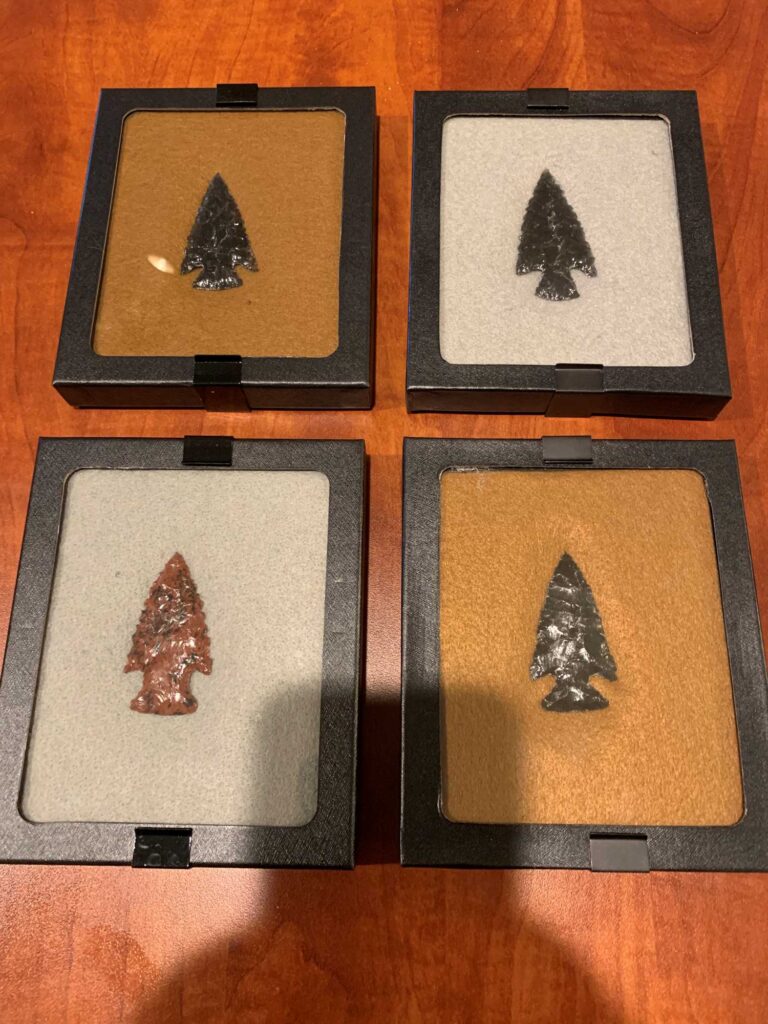
The Bryan Brown Youth Academy is a week-long camp for youth from the Tohono O’odham Nation. It is organized by Brown’s fellow law enforcement agents and serves youth between the ages of 14 and 17. I learned of the academy by chance. I happened to be present at a Tohono O’odham District Council meeting where one of these officers was presenting information about the academy to the Council members. I was there to talk about the proposed Great Bend of the Gila National Monument, and was scheduled after the officers on the agenda. After hearing all the information and that they were open to hearing ideas for outreach to the youth, I knew I had to give the officers my contact information.
I thought back to when I was between 14 and 17, and when I first joined the Coconino Rural Environmental Corps as a Youth Conservation member. It was “only a summer job,” but it had a profound impact on my life, and I believe was the catalyst that launched me into conservation and land protection. Today, I am truly grateful I had such an opportunity. And after hearing all the information about the academy, I thought, what better way to give back what was once given to me as a young kid from the reservation?
After a few meetings with the organizers of the academy, we found that our Hands-On Archaeology program would be a perfect fit. Allen Denoyer and Sara Anderson lead that program, and so the academy scheduled the three of us for a day on Mount Lemmon with 26 youth from the Tohono O’odham Nation. To say I was excited would be an understatement!
As the date drew closer, we hired a new Preservation Archaeologist, Anastasia Walhovd (Red Cliff Band of Lake Superior Chippewa), for our BIA ARPA Assistance Program. She was in Tucson for a week of onboarding and getting to know the office and staff. I asked her if she’d be interested in joining us, and she was more than willing. So, on the morning of the 6th, me, Sara, and Anastasia followed Allen Denoyer and longtime volunteer Rocky Hettinger up the mountain to the camp.
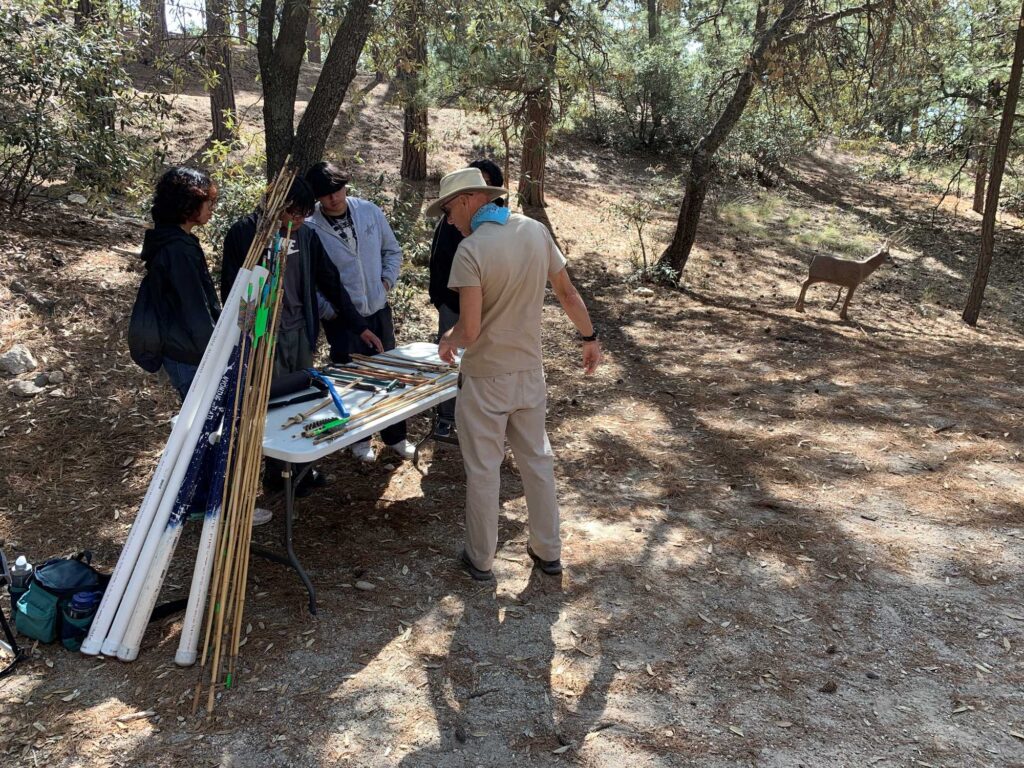
We provided a very general introduction to what archaeology is, what Preservation Archaeology is, and how people in the past would have used the replica atlatls and rabbit sticks we brought. Then the fun part came. Half the kids in the academy joined us, while the other half went to learn to rappel. The other half would switch and join us in the afternoon. The kids took turns throwing atlatl darts, side-arming rabbit sticks at teddy bears, and making pendant necklaces from soapstone and hemp cord. Sara, Allen, Anastasia, Rocky, and I took turns at each activity station teaching and learning from the kids. Competitions started and games were made up, as the kids quickly proved they were much more adept at throwing darts and sticks than we were.
After a few hours, it was time to sit down with the whole academy for lunch. But before lunch, Allen had the chance to demonstrate flintknapping, and in 30 minutes he showed how a chunk of obsidian can be skillfully transformed into an atlatl dart. As we ate, conversation flowed, and then the floor was given to Jon Proudstar, whom you may know from his role as the father of Willy Jack in the hit series “Reservation Dogs.” If you haven’t watched the series yet, I highly recommend you do so! Jon was there to speak about his own youth, to share how he came to find his path as an actor, and to offer some good wisdom to the youth in the room. I learned a lot from his talk myself.
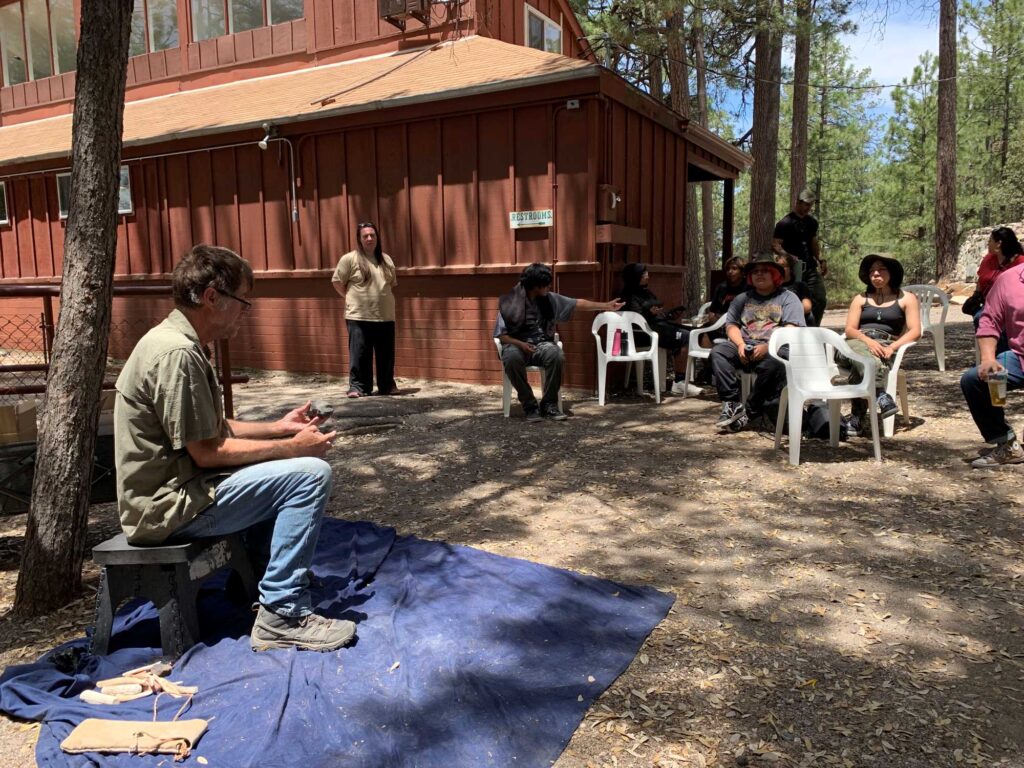
Lunch ended and we took some time to think about how we could organize the activities in a way that made more sense, given what we learned that morning. The second half of the kids joined us and we repeated our three activities, offered some space for a representative from the conservation organization Wild Arizona, and took some time to talk a little more about archaeology. Sara and I had to leave early, but we felt confident that Allen, Rocky, and Anastasia could conclude the day well.
When I got back to the office I sat quietly and reflected. I felt good about how we had spent the day, and hopeful that one of those young people might end up studying archaeology or conservation. Archaeology Southwest says “Thank you!” to the Bryan Brown Youth Academy’s participants and organizers. We hope to return when the next academy rolls around!
Here are my colleagues to say a little about their own experience and thoughts on the day.
Anastasia:
Imagine my delight in getting to spend a day at summer camp in my first week of work at Archaeology Southwest! It was an absolute joy to share my interest in and passion for archaeology with the youth at the Bryan Brown Youth Academy. I was tasked with running the rabbit-stick station and teaching everyone how rabbit sticks were used for targeting small game and how to throw them. I began each session by teaching the basic throwing technique while aiming at stuffed animals low on the ground. Most kids picked up on throwing the rabbit sticks with ease and, after a little practice, the competition would begin! After we placed the stuffed animals in spots of varying difficulty on the forest floor below the ponderosa pines, participants took turns aiming for the small (stuffed) game and earning points to contribute to their final score. Competition often heated up, and sudden-death tiebreaking rounds were required frequently throughout the day.
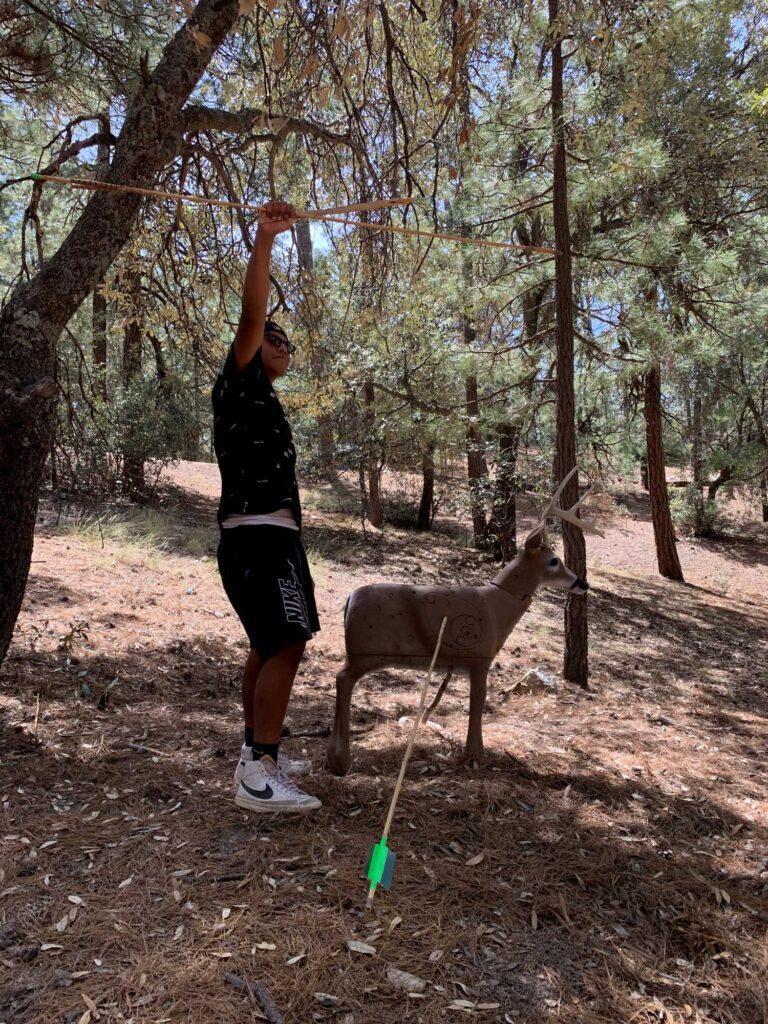
As a fan of “Reservation Dogs,” I was so excited to meet Jon Proudstar and hear the inspiring story of how he came into his work in the business of film and TV. Sharing my own work as the new Preservation Archaeologist with Archaeology Southwest and how I support SaveHistory.org may not be as thrilling as being a movie star, but I was still honored to share the work we do to better detect, respond to, and prevent archaeological resource crime (ARC), and to restore archaeological sites on Tribal lands that have been affected by ARC. As a former Wisconsin Tribal Conservation Advisory Council intern, I have seen how impactful it is to have high-school-aged Tribal youth experience positive and engaging interactions with outdoor professionals such as archaeologists.
Even more impactful are the incredible memories these youth will have made with their peers in the breathtaking and environmentally diverse location of Babad Do’ag (Mount Lemmon) within their ancestral homelands. I feel truly privileged to have been able to be a part of that experience, and I hope to participate in the Bryan Brown Youth Academy again next year. Miigwech (“thank you” in my Indigenous language Ojibwemowin) for letting me spend the day at summer camp!
Sara:
One of my favorite aspects of Archaeology Southwest’s Hands-On program is the work we do with the community, especially with young people. Spending a day on Mount Lemmon with the Bryan Brown Youth Academy was one of these special moments.
As we drove up the winding road, we had the chance to appreciate Tucson from a distance, offering a perspective that the day-to-day routine often obscures. It was also an opportunity to get to know Anastasia better. Throughout the day, I saw her archaeology skills in action, along with her ease in outreach and game-making.
Spending time with the youth and staff of the academy was the highlight of the day. I was thrilled to witness the excitement, inspiration, creativity, and skill of everyone involved. The joy of the Hands-On experience lies in its structure—Allen has designed the activities for immediate hands-on interaction. Instead of long talks about history or archaeology, participants are encouraged to dive in and get their hands dirty right away. This approach fosters new ideas, inspired questions, and, overall, a lot of fun.
I appreciate my colleague Skylar for making this day possible and for connecting us with the Bryan Brown Youth Academy. I hope we can continue this collaboration far into the future.
Wild Arizona Youth Conservation Corps
On Saturday, June 29, the team had another opportunity to reach out to members of Wild Arizona’s Youth Conservation Corps. My time in a Youth Conservation Corps program led to me leading all-Indigenous trail crews in beautiful places such as Grand Canyon National Park, Saguaro National Park, and—fittingly—Chiricahua National Monument. I say “fittingly” because this day of outreach was spent in the Chiricahua Mountains, where it was easily 20 degrees cooler than Tucson.
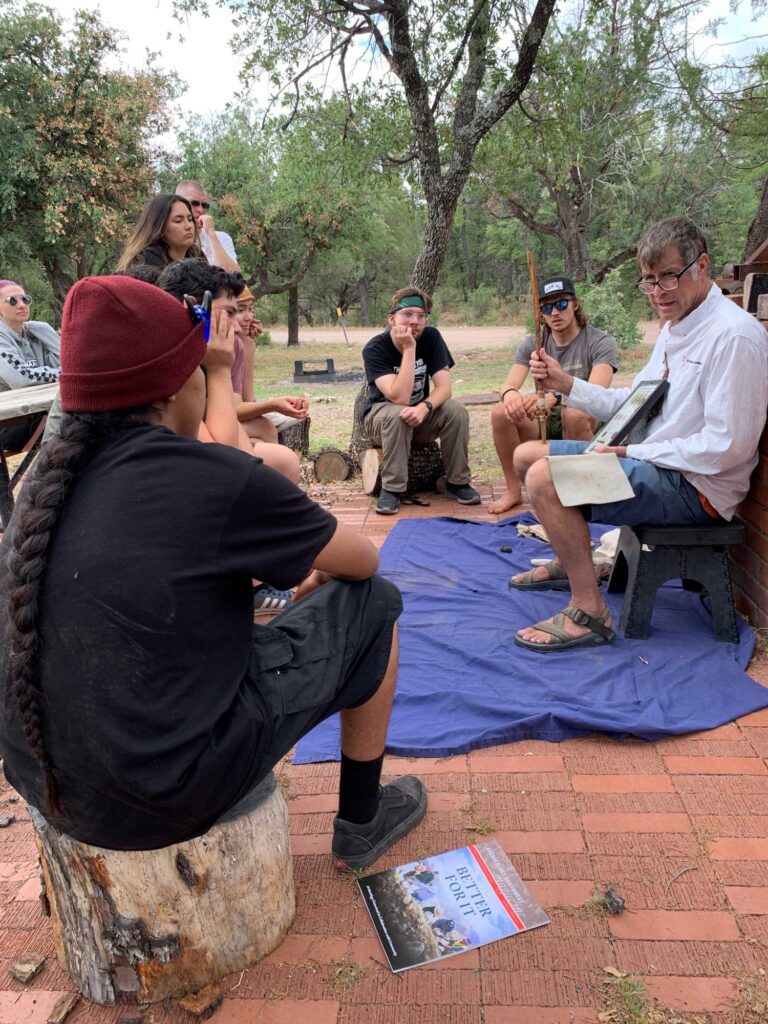
I learned of this program from their Volunteer and Community Engagement Coordinator, Nizhoni Baldwin. She is a fellow Diné relative who herself came up in the Ancestral Lands Conservation Corps. Her passion for conservation has now come full circle as she works to bring more Indigenous youth into the field of conservation. I was happy to contribute to that goal in a small way with Allen and Sara that day.
Many of the activities were the same as our day with the Bryan Brown Youth Academy. First, some flintknapping demos; then, time spent throwing atlatls and rabbit sticks and making pendants. This time around, though, I facilitated an educational activity called “Hidden Narratives.” Essentially, the activity’s goal is to provide an overview of the history of the colonization of Indigenous Peoples in what is now America, and to explain how land dispossession and theft is a key part of colonizing Peoples. On a parallel timeline, it also lays out some of the key pieces of legislation and events that today allow for public lands, conservation, land management, and land protection.
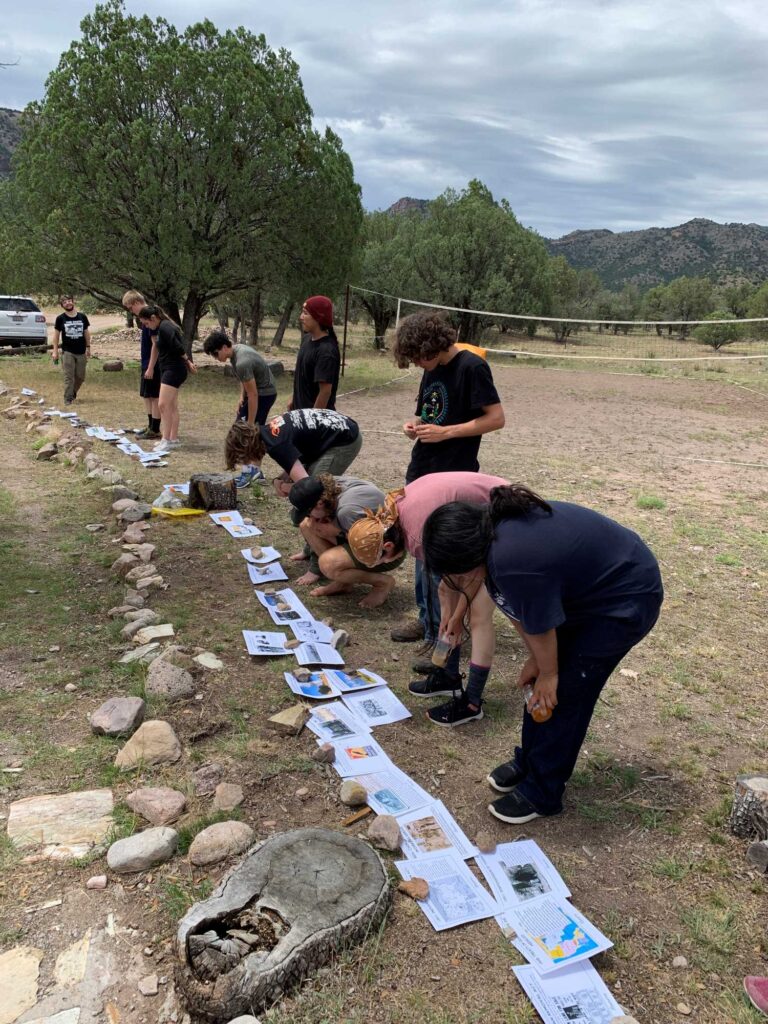
Reconciling this dark history and its ongoing effects on Indigenous Peoples has been a big part of my path in conservation, and, more importantly, how I go about the work. My position is that BIPOC and Indigenous Peoples should no longer be excluded from conservation work, and in fact should be Co-Managers of public lands alongside federal agencies. The kids asked very insightful and somewhat difficult questions in our discussion after the activity, and I was glad to know that they now have some context that makes it possible for everyone to have access to and be stewards of today’s public lands.
Here again, I’ll pass the pen to my colleague.
Sara:
It was another exciting Hands-On Archaeology session with the Wild Arizona Youth Conservation Corps in the Chiricahua Mountains. Having never been there, I was excited to see what this remote and quiet part of Arizona was like. The natural beauty and perfect weather made it an ideal setting for a day of learning and fun.
Allen brought atlatls and darts, rabbit sticks, and materials for making pendants. His flintknapping demonstration was a highlight; as anyone who has met him will agree, he has a unique talent for being informative and entertaining. Seeing everyone, including the parents, actively participating and learning new skills in the smaller group activities was delightful. The enthusiasm and quick learning displayed by everyone made the day so fun and rewarding.
Skylar wrapped up with a discussion about Indigenous lands and the laws that have shaped the public land system in the United States. His passion for protecting and advocating for public lands was evident, and he inspired the young conservationists to play an active role in this important work.
The passion and joy that the youth showed throughout the day are exactly why Allen and I love the Hands-On program. It was a privilege to see Skylar share his expertise with such a dedicated conservation group. This experience left me feeling excited about our work and hopeful for the future, knowing that these students’ attitudes and interests will carry on the important work we do. Overall, it was a beautiful and fulfilling day in a stunning location. The Chiricahua Mountains provided the perfect backdrop for an unforgettable experience.
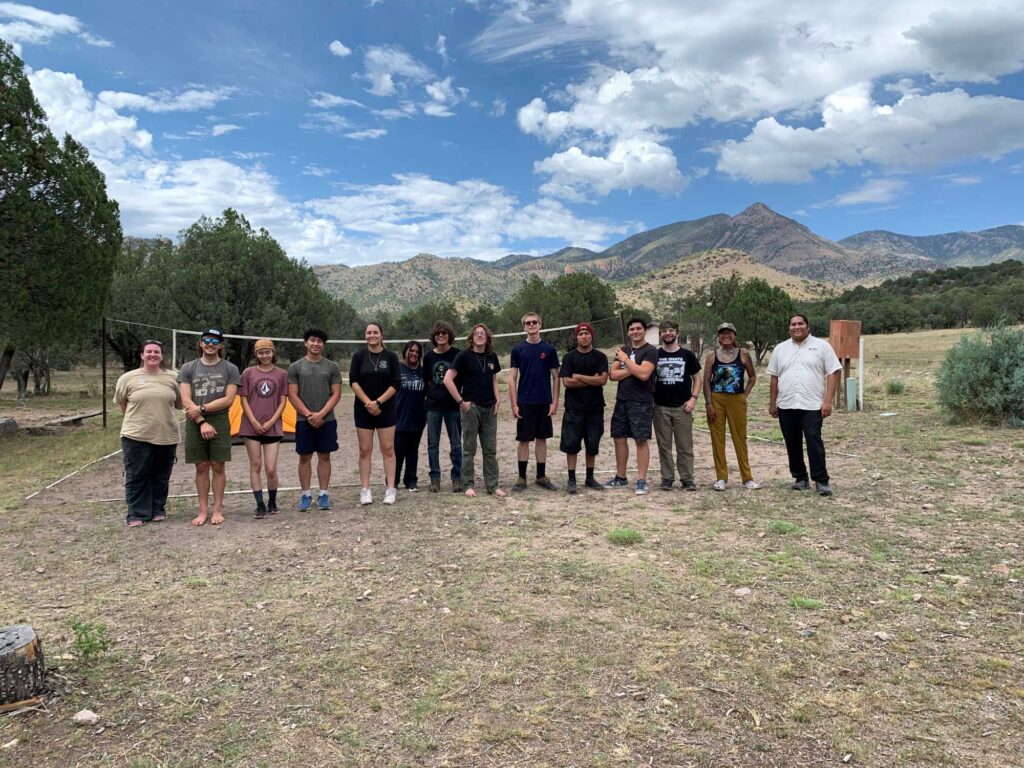
San Lucy District of the Tohono O’odham Nation
On July 5, yet another opportunity to reach out to Indigenous Youth presented itself. The Tohono O’odham Nation comprises 11 Districts, each of which has its own District Council made up of a Chairman, Vice-Chair, Secretary, Treasurer, and multiple Councilmembers. One of these Districts is the San Lucy District. Located north of the Town of Gila Bend, San Lucy is the closest community to the proposed Great Bend of the Gila National Monument. For the past few years, it has been a priority of mine to understand and address the community’s concerns and questions about the national monument.
Throughout that time, I have also had the opportunity to meet the heads of various departments within the District. Within the education department, there is a program for youth in the community to be employed by the district to gain some work experience. I was invited by the Summer Youth Monitor to spend a day with students in the program. Sara joined me again. And although Allen Denoyer was busy with our Field School in New Mexico, Shannon Cowell was able to come along to represent the BIA ARPA Assistance Program and Save History.
Summer was in full swing at that point, and we had to adjust our activities accordingly. We stuck to activities that could be done indoors, so the atlatls and rabbit sticks stayed back this time around. I took the opportunity to talk about the proposed national monument, as well as give some context about the National Conservation Lands. While we made pendants and etched some shells, many of the kids began asking me questions about how I ended up in my position, where I came from, and why I choose to do the work I do. I was happy to answer, but I was also happy just to sit beside them as they conversed, teased each other, and laughed. It brought me back to my days as a kid on the Navajo Nation. Humor and laughter are good medicine, and always a big part of any Indigenous community. I was pleased to laugh alongside the youth as we made our pendants.
Here’s what Shannon would like to share.
Shannon:
I appreciated this opportunity to escape the office and connect with the youth workers program in the San Lucy District. In my daily work for the ARPA Assistance Program, I usually speak with experts like archaeologists, law enforcement agents, and Tribal officials when cultural resources are destroyed through greed or negligence. I found translating these issues for a younger generation within an Indigenous community to be a thought-provoking challenge.
I presented on SaveHistory.org and our program’s efforts to combat looting and vandalism both online and on-the-ground. We all participated in an adapted version of the “Hidden Narratives” activity Skylar mentioned above. The adapted activity focuses on braided histories of desecration and disrespect for cultural sites and burials (starting with the Pilgrims) and corrective actions and repatriations led by Tribes (like the return of the Ni’isjoohl memorial pole). One youth shared that they would remember the story of the theft of the Talaotumsim and how no Hopi boys have been initiated in almost 50 years. Another asked about schooling and job opportunities, especially on the “cultural side” of archaeology.
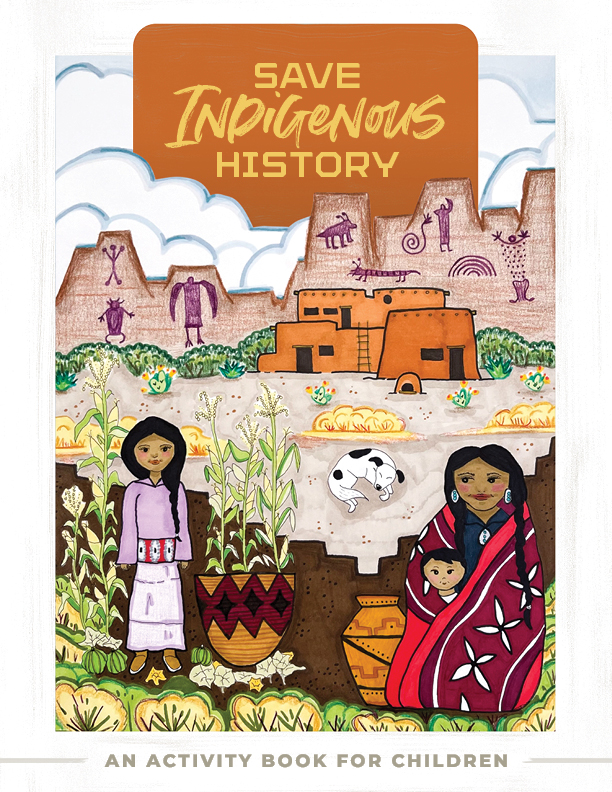
As an ever-evolving nonprofit, Archaeology Southwest is uniquely positioned to connect with communities and share what we do in an accessible way. It was an honor to work alongside my colleagues Skylar and Sara and learn from their example. I hope we ignited some curiosity in archaeology and cultural resource management—we need the next generation on board to solve wicked problems like theft and destruction of cultural heritage.
Explore the News
Related to This
-
Project Hands-On Archaeology
-
Project Save History & the ARPA A...